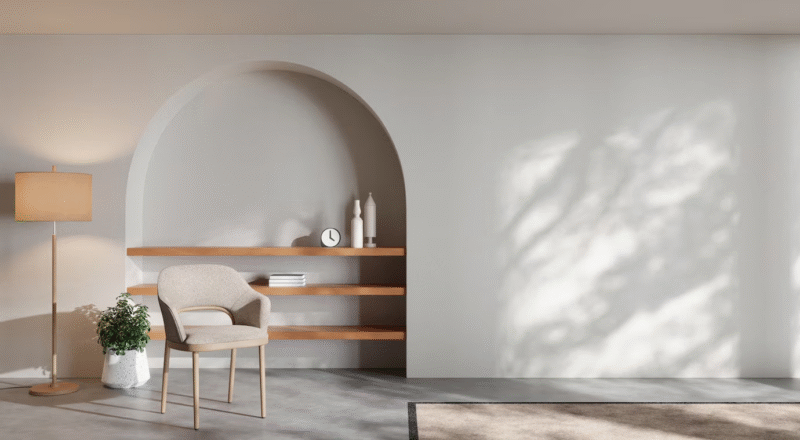What is Minimalism
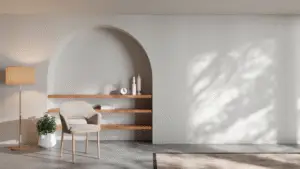
Clean lines, simple and uncluttered rooms which invite you in personify minimalism. In a hectic world, using minimalist style can make your home feel serene and welcoming after a long day. Although it originated in the 1950’s, Minimalism is timeless, because of its easily maintainable and neat aesthetics. Minimal style can make a small space look spacious and adds quiet and subtle luxury to the living environment. Who doesn’t love their space to be elegant and functional at the same time. Although it looks easy to do with just a few pieces of furniture on a white backdrop, such a space may be stark and uninviting. A warm and welcoming space with minimal style is achieved by careful layering of certain elements with precision to give a look of ease. Let’s look at it in detail.
Origin of Minimalism
Like many other style forms, minimalism in interior design evolved from Minimalist art. In the 1950’s, the period when Pop art and Expressionism were at their peak, Minimalism evolved as a counter art form. And by the 1960’s it became a movement in architecture and design. It follows the motto of Ludwig Van Der Rohe – “Less is More”. In Minimalism Focus is given to the need or function of an object. It rejects highly decorative and lavish elements.
Making your home Minimal
Minimalism at home is not just a style expression, it is an extension of a lifestyle. It can help keep your home clutter free, keep the focus on your cherished objects and showcase your lifestyle. It can even be a philosophy and way of life. Here are a few different ways you can incorporate minimal style in your home.
Spatial Organisation
Minimalism in interior design means open plan and clean lines. There is a connection between interior and the outside with minimal walls, large openings and natural light. Everything in the room is chosen for its purpose. There will be nothing extra. Nothing which is unnecessary. Nothing that has no need to be there in that space. Everything that is present, is there for a reason and each thing has its own function.
Natural Light & Lighting
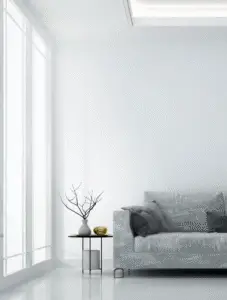
Large windows and openings bring in light and make rooms warm and vibrant. Letting natural light to brighten the room and minimising the need for artificial light in the daytime makes the space light and airy. Lighting is done through soft lighting of walls with concealed light fixtures. Visible light fixtures are in simplistic designs and neutral colors. Accent lighting can be through floor or table lamps which are again of minimal design. Led Strip lighting in a warm tone makes sure there are no dark corners. Concealed lighting under ceiling, cabinets or furniture can make the room glow. The play of light and shade through the use of blinds or patterned lights can make a minimal space look ethereal.
Color and Material Palette
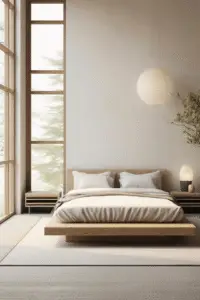
Black, white and neutral colours in shades of beige are what come to mind when minimalism is mentioned. These colours can make a space appear large and open. However carefully selected darker shades in earthy or even jewel tones for specific areas can highlight those areas and add contrast to the space creating a feel of layered luxury. Here are a few different combinations to get you going.
White, Eggshell & wood – add deeper darker wooden shades to increase the warmth.
Black, White and Silver – Using black in accent elements, furniture pieces or even stone flooring can make your room distinct.
Adding a pop of green – adding green can instantly make a room feel calm and comforting. Opt from a range of bold emerald or a serene cerulean to ground your space.
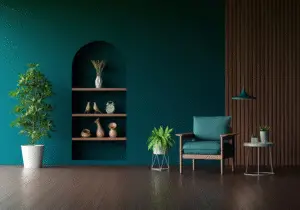
Minimal style can be termed as boring when it is just plain white walls. However, With selection of few different materials which can provide texture and contrast a minimalist room can still be visually interesting. This can be achieved through the following:
Having one wall in a complementary colour or contrasting texture.
Adding wooden elements like fluted textures and wood shelves and niches to otherwise plain walls.
Subtle Texturing – Using wall textures in colors of the room but with variations of textures like 3d plastering, wall grooves, matte finishes etc.
Gold or Silver accents in lamps, lighting fixtures and trinkets can add elegance.
Create visual interest using Minimalist wall art in complementary colors.
Turn around things by opting for textured flooring or ceilings in neutral tones.
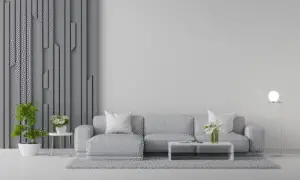
Furniture
Every piece of furniture in a minimalist room is chosen for its required use. Low level furniture with clean lines and geometric shapes are preferable. Attention is given to shape, colour and texture.
Light coloured furniture in metal or wood with white beige or neutral toned upholstery makes the room look large and spacious.
Invest in classic timeless pieces that are solid, easy to maintain for daily use and long lasting.
Soft Furnishings
Rather than plush cushions and frilled curtains, minimal style focuses on simple straight shapes. Single colour curtains, Solid blinds, Minimal Rugs and geometric cushions add to the minimal style. Some furnishings in a bold contrast can elevate the style of the room.
Showpieces
In a minimalist room Showpieces are less – have a few selected focus points which are functional and also have a sentimental value. They can be a lamp to read your favourite book, trinkets purchased during your travel, your favourite artwork, family photos or even vases to hold your beautiful flowers. Make sure that the items chosen are not frivolous and gaudy. Grouping together selected items can add interest and they will be conversation starters. Choose items of a similar color palette so that the whole room comes together.
Plants
The vibrant greens of indoor plants complement the muted and neutral color tones of a minimal styled home. Choose plants with large leaves, distinct shapes and patterns. An easily manageable plant adds to the minimal theme.
You can also go large, bold and bright to make the plant be the focus of the interior.
The plant pots can be of muted colors and minimally designed to share the connection with the overall theme of the room.
Some plants which complement a minimal style are Sansevieria, Monstera sps, Areca Palm sps
Storage
All things in our homes collect dust. Tables filled with things, overflowing laundry, layers of pillows and every item everywhere. They are what make our home cluttered and bring in allergens and dust mites. A minimalist design can make your home feel clean and tidy.
However, a minimal home loses its function without storage options. Opt for concealed and easily accessible storage cabinets. Reduce open shelves that show everything that is inside. Open shelves are only to place accent pieces. Wicker baskets are a great way to store necessary items and still look elegant. Multipurpose furniture with concealed storage, textured sliding panels that look like walls but are essentially hidden closets are all great ways to maximize storage but still make the space visually minimal.
Minimal Interiors are good for you?
Do you feel…Anxious in a cluttered room? Gloomy in a dark room? Stressed or hurried in a too bright room? Trapped in a too small room?
Then Minimal interiors are for you.
Research shows that the rooms you live in can affect how you feel. These studies have given an emerging field called Neuro – architecture which says that spaces done the right way can be healing. This is the reason Minimal interiors are preferred in today’s world.
They are simple and symmetrical in design and layout, thereby giving you a happier outlook when you walk in the door. If you are feeling overwhelmed by the clutter around you and looking for a solution to make your home into a safe haven, try out the minimal approach in your home.
All Images courtesy – Designed by Freepik
About the Writer
Ar Abisha Dhas M.Arch. Landscape is the Principal Architect at Yesar Architects, a multidisciplinary Architectural firm at Nagercoil. She is an avid reader and loves teaching. Find her at @yesararchitects on Instagram.
